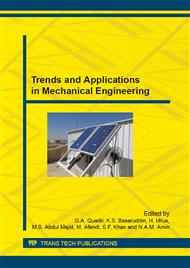p.300
p.305
p.311
p.318
p.323
p.328
p.334
p.340
p.345
Response Surface Methodology Modeling of Drill Exiting Damage Factor in High Speed Drilling of GFRP Using HSS Twist Drill Bit
Abstract:
This paper presents a research on experimental and response surface methodology (RSM) approach in evaluating the damage factor of the drilled holes in high speed drilling of glass fiber reinforced polymer (GFRP). From the experiment, the influences of drilling parameters toward damage factor are more prominent in thicker GFRP; where high speed drilling using high speed steel twist drill bit produces lower damage factor in thicker GFRP. Lastly an optimized set of drilling parameters was generated for the use of high speed steel twist drill bit in high speed drilling.
Info:
Periodical:
Pages:
323-327
Citation:
Online since:
August 2015
Authors:
Price:
Сopyright:
© 2015 Trans Tech Publications Ltd. All Rights Reserved
Share:
Citation:


